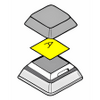Help your hands by cutting clicks
Help your hands by cutting clicks
Vote: (1 votes)
Program license: Trial version
Developer: GentleMouse
Version: 2.0
Works under: Windows
Vote:
Program license
(1 votes)
Trial version
Developer
Version
GentleMouse
2.0
Works under:
Windows
Pros
- Reduces the risk of RSI and other mouse-related injuries
- High level of customization options available
- Allows for normal mouse operation alongside its use
- Easy-to-understand tutorial and straightforward interface
- Beneficial for users with varying needs and computer skills
Cons
- Initial learning period required to become proficient
- May not be necessary for users without specific ergonomic needs
GentleMouse is an innovative software tool designed to alleviate the strain of repetitive mouse clicking for Windows users. It serves as an excellent solution for those suffering from musculoskeletal injuries or conditions like Repetitive Strain Injury (RSI) or Carpal Tunnel Syndrome. The software aims to make the computing experience more comfortable and less painful by introducing an alternative to the traditional method of mouse operation.
User Interface and Accessibility
Upon installation, GentleMouse presents a user-friendly interface that is unobtrusive, seamlessly integrating with the usual desktop environment. When activated, a trigger window appears whenever the cursor hovers over a clickable area. This trigger window is the gateway to performing mouse actions without the need for actual clicks.
Customization Options are plentiful, ranging from the visual aspects such as color and font to functional settings like dwell time adjustment. The latter determines how long you need to hover over an option before an action is executed. This ensures that users can tailor the software to their individual needs and preferences.
Functionality and Performance
GentleMouse is designed to replicate all standard mouse functions without the need to click. Users can perform right-clicks, double-clicks, drag-and-drop actions, and scrolling by hovering over the appropriate options. The software operates under the principle of dwelling over a selection, thus eliminating the physical strain of clicking.
The program is intuitive once the learning curve is surpassed. New users may take a brief period to acclimate to the dwell-click method. However, after a short adjustment phase, many find GentleMouse to become second nature, integrating itself as a natural extension of their regular computer use.
Ease of Use and Learning Curve
While GentleMouse does come with a learning curve, the transition is made smoother by resources provided by the developers. A helpful tutorial video on the website is available to guide users through the initial setup and usage stages. Few minutes of hands-on practice are usually sufficient for users to get the hang of the application.
Compatibility with Standard Mouse Use
One of the strong points of GentleMouse is its complementary functionality. The software does not disable your mouse but rather provides an additional method to perform clicks. This dual functionality means that users can still use their mouse in the traditional sense whenever they prefer, offering flexibility in how they interact with their PC.
Conclusion
GentleMouse is a cutting-edge solution designed to cater to a niche yet significant segment of users who encounter discomfort during extended mouse usage. With features aimed at reducing physical strain and potential for injury, it is more than a convenience—it’s a necessity for people predisposed to hand and arm strain.
Pros
- Reduces the risk of RSI and other mouse-related injuries
- High level of customization options available
- Allows for normal mouse operation alongside its use
- Easy-to-understand tutorial and straightforward interface
- Beneficial for users with varying needs and computer skills
Cons
- Initial learning period required to become proficient
- May not be necessary for users without specific ergonomic needs




